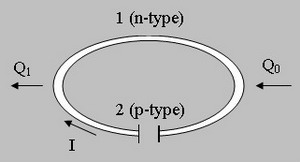- Home »
- Тechnology »
- Historical Background
Thermoelectric phenomenon was discovered more than 180 years ago. However, it enjoyed its practical application in the middle of the XX century, 130 years later after its discovery thanks to the research work of Soviet academician Abram Ioffe.
Still, the pioneer in thermoelectrics was a German scientist Thomas Johann Seebeck (1770-1831), who was born in the Estonian town Revel. In 1822 he summarized the results of his experiments in the article called The Magnetic Polarization of Metals and Ores Produced by Temperature Difference (Magnetische Plarisation der Matalle und Erze durch Temperatur-Differenz. Abhandlungen der Preussischen Akad, Wissenschaften, pp 265-373) that was published in the Proceedings of the Prussian Academy of Sciences. Seebeck discovered that if the ends of the circuit consisting of two heterogeneous metals soldered under different temperature conditions were closed, a magnetic needle placed near it would rotate as if there were a magnet applied. The angle of rotation depended on the value of the temperature difference at the circuit junctions. This physical phenomenon is referred to as the Seebeck's effect.
However two years earlier, in 1820 Hans Christian Oersted (1777-1851) proved that electrical current affected the magnetic needle. Later on as Ampere, Biot, Savart, Laplace, and other scientists studied the interaction of electrical current and magnetic field, Seebeck disclaimed the electrical nature of the phenomenon. As the name of his article demonstrates, his scientific idea concerned magnetization of materials under temperature difference. According to this hypothesis, the Earth was like a gigantic circuit where temperature difference was kept with the two cold poles and with the hot equator. At least, this was Seebeck's point of view on the Earth magnetism.
Hans Oersted, who followed the thread of Seebeck's research work with much attention, was the first who named this phenomenon thermoelectric effect. Seebeck himself insisted on the name of thermomagnetism.
Seebeck gathered much research material that dealt with circuits consisting of various combinations of hard and liquid metals, alloys and compositions of metals and effect of temperature difference on them. Basing on this research work, he founded "thermoelectric row", which is still in use along with those, which were composed later.
 The Peltier effect was discovered in 1834, 12 years later after Seebeck's breakthrough. Compared with the Seebeck's effect this is a counter phenomenon. The Peltier effect occurs whenever current passes through the circuit of two dissimilar conductors; depending on the current direction, the junction of the two conductors either absorbs or releases heat.
The Peltier effect was discovered in 1834, 12 years later after Seebeck's breakthrough. Compared with the Seebeck's effect this is a counter phenomenon. The Peltier effect occurs whenever current passes through the circuit of two dissimilar conductors; depending on the current direction, the junction of the two conductors either absorbs or releases heat.
This phenomenon was discovered by French physicist and meteorologist Jean Charles Athanase Peltier (1785-1845). By the way, physics was just a hobby for him. Previously, he worked as a watchmaker at Brege. In 1815 after he inherited some property, he decided to devote himself to his hobby, in other words, he decided on conducting physical experiments and doing meteorological observations.
Like Seebeck, Peltier interpreted the results of his research work in a wrong way. For example, his discovery stated that the Joule - Lenz law, which determined that the current passing through circuit releases heat, was not valid when low a current passed through the circuit.
Only in 1838 Russian academician Emily Lenz (1804-1865) proved that the Peltier Effect was an autonomous physical phenomenon, which consisted in releasing and absorbing of additional heat on conductor's junctions when a current passed through them. Moreover, the nature of the process (heat absorption or release) depended on current direction.
Twenty years later William Thomson (later Lord Kelvin) issued a comprehensive explanation of the Seebeck and Peltier Effects and described their interrelationship. This thermodynamic derivation made it possible for Thomson to predict the third thermoelectric effect, now known as the Thomson effect. In the Thomson effect, heat is absorbed or produced when current flows in material with a certain temperature gradient. The heat is proportional to both the electric current and the temperature gradient.
The discoveries triggered the development of a new engineering field - thermo power engineering, which studies processes of conversion of thermal energy into electrical power (the Seebeck Effect) and thermoelectric heating and cooling (the Peltier Effect) as well.
As mentioned before, the outstanding Russian scientist, a great expert in physics, academician Abram Ioffe was one of the primary investigators of thermoelectric phenomenon (1880-1960). His research work run in the early 30th served as the basis for the future development of thermoelectric power engineering.
Kryotherm carries on traditions founded by Abram Ioffe and his research institute. Within the last ten years our engineers and researchers have done a great breakthrough in the development of high effective thermoelectric materials and manufacturing of cooling devices and power generating systems based on the Peltier effect. The range of thermoelectric applications grows constantly. Following this trend, Kryotherm constantly widens its product range.
We are sure that environmentally friendly cooling devices and power generating systems based on thermoelectric effect would be the core of the most prospective technologies of the future.



